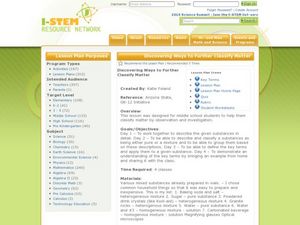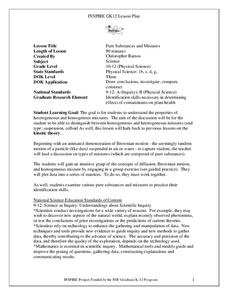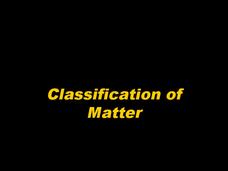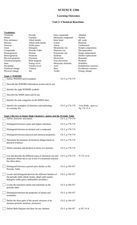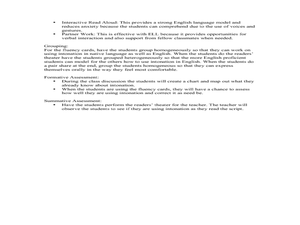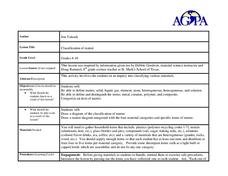Curated OER
Discover Ways to Further Classify Matter
Students analyze and classify substances. In this classifying matter lesson plan, students look at various substances and identify them as heterogeneous or homogeneous mixtures, pure substances, or solutions. Students bring...
Curated OER
Equilibrium Equations
In this chemical reactions learning exercise, learners calculate the equilibrium constant for given reactions. Students decide if reactions are homogeneous or heterogeneous and if the equilibrium favors reactants or products. This...
Mr. E. Science
An Introduction to Matter
What's the matter? Gas, solid, liquid, or plasma. The presentation covers how to describe and identify matter, changes in matter, types of matter, measuring matter, particles of matter, Democritus, and John Dalton's Atomic Theory.
Lee & Low Books
First Come the Zebra Teacher’s Guide
Accompany a reading of First Come the Zebra written and illustrated by Lynne Barasch with a teacher's guide equipped with before reading, vocabulary, and after reading activities. Additional social studies,...
California Education Partners
My Five Senses by Aliki
An assessment designed to examine scholars' reading comprehension skills takes place over three days. Starting with a read-aloud of My Five Senses by Aliki, learners then take notes and discuss their most memorable moments with...
Teacher's Corner
Brandon's Baseball Collection
Ten questions make up a activity that challenges baseball enthusiasts to read a graph then answer questions pertaining to the data's range, mean, median, and mode.
K20 LEARN
Break It Apart: Multiplication Strategies
Reinforce multiplication strategies with a lesson plan that examines a word problem and the distributive property. Mathematicians work collaboratively to solve the problem, create a poster with their solution, and share their preferred...
Curated OER
Scientific Method
For this scientific methods worksheet, students compare independent and dependent variables, hypothesis and theory, homogeneous and heterogeneous, and physical and chemical change. This worksheet has 17 short answer questions.
Curated OER
Pure Substances and Mixtures
Learners compare and contrast the properties of substances and mixtures. In this chemistry lesson, students simulate spontaneous mixing by performing a short class activity. They differentiate heterogeneous and homogeneous mixtures.
Curated OER
Mixing in the Kitchen
Young scholars identify the different types of mixtures. They identify examples of solutions, suspensions, colloidal dispersions, and emulsions through a game and basic experiments.
Perkins School for the Blind
Mixtures and Solutions
Mixtures and solutions are different; one can be separated fairly easily and the other cannot. This hands-on experiment was written specifically for learners with visual impairments or blindness. They will use lemonade and trail mix to...
Curated OER
Classification of Matter
Thirty-seven slides thoroughly shed light upon the four classes of matter: elements, compounds, mixtures, and solutions. Also covered are chemical symbols, molecules, and chemical equations. The colors and fonts chosen for the...
Curated OER
Bring Literature Circles Into Your Classroom
Tips and strategies for adding literature circles to your language arts curriculum.
National Institute of Open Schooling
Colloids
Classes explore colloids through readings and questions in lesson 10 in a series of 36. They learn everything from methods of preparation and properties to how to classify colloids. They finish the lesson by seeing how to apply...
Curated OER
Atomic Theory
An extremely thorough presentation walks new chemists through the basics of matter. There really isn't a unifying theme, however So many topics are covered: forces, elements, atomic structure, chemical properties, compounds, quarks,...
Curated OER
Alloys
Tidy slides and lecture notes for each are included in this presentation on alloys. Instruction begins with the molecular arrangement of a pure element, gold, and progresses to a few example alloys: brass, steel, and nitinol. This...
National Institute of Open Schooling
Chemical Equilibrium
Le Chatelier's interest in thermodynamics and building materials such as cement and plaster led to the Le Chatelier Principle in 1884. Activity 13 in a series of 36 extensively explores chemical equilibrium. Learners read about...
National Institute of Open Schooling
Adsorption and Catalysis
Adsorption, not absorption, is when atoms stick to the surface of an object, like water sticking to a grain of sand. An informative lesson delves into adsorption, teaching physical and chemisorption and the factors that affect them....
Curated OER
Learning Outcomes
In this science activity, students explore the learning outcomes for a unit on chemical reactions. Students define 60 vocabulary words and answer a list of questions for each topic.
Curated OER
Reading (Fluency)
Emerging readers practice reading fluency. First, they listen to the teacher and classmates model fluent reading, and then they practice fluent oral reading with a partner. To close the day, they participate in a Reader's Theatre based...
Learning Links
The Josefina Story Quilt Study Guide
Considering using The Josefina Story Quilt in your classroom? Check out this sample teaching guide for a list of pre-reading activities.
Curated OER
Classification of Matter
Students investigate common household items and classify them into types of matter. In this matter lesson, students group given items into categories based on their characteristics. They also complete a concept map about matter and...
Curated OER
Properties of Materials - Part B
Learners describe the history of materials. They use the kinetic (particle) theory to explain changes of state in matter and trace the flow of heat during changes of state and chemical changes.
Curated OER
Final Worksheet
High schoolers will review a semesters worth of material on this final chemistry review. Information ranges from naming isotopes to pH and molarity.
